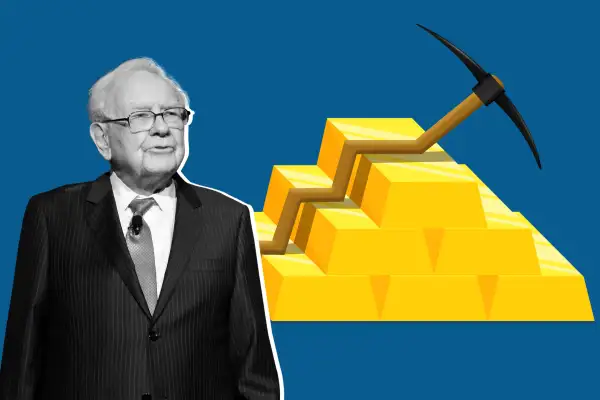Warren Buffett Just Bet Big On Gold Miners. Should You?
Money is not a client of any investment adviser featured on this page. The information provided on this page is for educational purposes only and is not intended as investment advice. Money does not offer advisory services.

Gold already had the attention of investors in 2020, as a safe haven in turbulent times that soared to record highs.
But now it has some additional backing, in the form of a promising young investor by the name of Warren Buffett.
The Oracle of Omaha’s Berkshire Hathaway disclosed a purchase of almost 21 million shares of producer Barrick Gold Corp., worth more than half-a-billion dollars, making it the firm’s 11th-largest shareholder with over 1% of the company.
The buy sent shockwaves through the sector, since historically, Buffett and right-hand man Charlie Munger have turned up their noses at gold as a productive resource. The precious metal is “way down on my list as a store of value,” Buffett once quipped in 2005.
But strange times make for strange investment bedfellows. It also raises the larger question, of the relative pros and cons of owning shares in gold mining companies, as opposed to the physical resource such as through a gold-backed ETF.
“Some investors might not have even looked at gold before, but at this price it has become attractive to them,” says Colin Hamilton, managing director of commodities research at BMO Capital Markets. “This time seems a little different, because you have some important funds and investors like Buffett willing to back it.
“ETFs are a clean way of getting exposure, because you don’t have to do the hard work of understanding all these companies. But equities give you leverage, because the more gold prices move, the higher your potential returns. Of course not all equities are the same, so it comes down to picking the right ones.”
To be sure, stocks are a more dynamic asset than, say, a gold bar or coin. They throw off dividends and earnings, which explains why the equity route might appeal to someone like Buffett, who is terrific at spotting undervalued companies but isn’t really known as a commodity speculator.
He should be ready for a wild ride, though: Gold-mining stocks tend to be rewarded highly in good times, and punished severely in bad times. “Gold and precious metals equities have historically outperformed the price of gold by twofold to threefold when both bullion and precious metals mining stocks are rising,” points out John Corcoran, a senior client portfolio manager for money managers Invesco, in a recent research note.
Valuing gold miners also requires a deep dive into complex issues like geopolitics, such as the nations and regulatory frameworks where the gold is being mined; the productivity and potential of particular mines, and the risk-reward of future projects; and the quality of management and company balance sheets, just to name a few.
For investors intrigued by gold stocks, there are more names than just Barrick to consider. Bank of America’s top picks, in a recent research note: Wheaton Precious Metals, Newmont Corp., and B2Gold.
The price is right
Of course, the one figure that defines the fortunes of all these companies: The price of gold. While it has enjoyed a stellar 2020 so far, analysts wonder how much of a run it has left. It recently edged over $2,000 an ounce, an all-time high, and has seesawed back and forth over that critical barrier.
“If you wound the clock back a few months, I would be shocked if you had told me where gold was going to be,” says Christopher Louney, a commodities strategist at RBC Capital Markets. “Both prices and investor interest are at all-time highs. It has really stepped into its role as a perceived safe haven, amid all this uncertainty.”
As always with rising asset prices, come the investors piling in. The exchange-traded fund SPDR Gold Shares has been flooded with almost $20 billion in new money since the beginning of the year, amounting to almost a third of its total assets.
Whether you go the route of gold-mining stocks, or a gold-backed ETF, the other key factor to consider is asset allocation. Such a decision is highly personal: If owning a somewhat non-correlated asset like gold helps you sleep at night and stick to your broader financial plan, then it can be a useful addition to your portfolio. It’s a traditional hedge against inflation, and a place to hide out from market carnage.
But as a speculative investment, it should fit into that particular bucket – say up to 5% of your portfolio, but not a larger and more basic building block like equity index funds or fixed income.
If you like the gold theme and are encouraged by the Warren Buffett investment, here’s an innovative idea from Salt Lake City adviser Devin Pope of Albion Financial Group: Buy some Berkshire Hathaway.
“That gives an investor some exposure to gold, but in a much more diversified way,” he says. “Their managers are probably going to do a better job of increasing or decreasing exposure to gold than the average investor. Why not piggy-back on one of the best investors out there?”
More from Money:
Congratulations! You Won Big Betting on Tech Stocks. Now Start Selling Them
‘I Feel a Little Bit Duped’: Online Banks Keep Cutting Rates, and Obsessive Savers Aren’t Happy